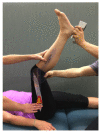Male and female runners demonstrate different sagittal plane mechanics as a function of static hamstring flexibility
- PMID: 26537812
- PMCID: PMC4647153
- DOI: 10.1590/bjpt-rbf.2014.0123
Male and female runners demonstrate different sagittal plane mechanics as a function of static hamstring flexibility
Abstract
Background: Injuries to runners are common. However, there are many potential contributing factors to injury. While lack of flexibility alone is commonly related to injury, there are clear differences in hamstring flexibility between males and females.
Objective: To compare the effect of static hamstring length on sagittal plane mechanics between male and female runners.
Method: Forty subjects (30.0±6.4 years) participated and were placed in one of 4 groups: flexible males (n=10), inflexible males (n=10), flexible females (n=10), and inflexible females (n=10). All subjects were free of injury at the time of data collection. Three-dimensional kinematics and kinetics were collected while subjects ran over ground across 2 force platforms. Sagittal plane joint angles and moments were calculated at the knee and hip and compared with a 2-way (sex X flexibility) ANOVA (α=0.05).
Results: Males exhibited greater peak knee extension moment than females (M=2.80±0.47, F=2.48±0.52 Nm/kg*m, p=0.05) and inflexible runners exhibited greater peak knee extension moment than flexible runners (In=2.83±0.56, Fl=2.44±0.51 Nm/kg*m, p=0.01). For hip flexion at initial contact, a significant interaction existed (p<0.05). Flexible females (36.7±7.4º) exhibited more hip flexion than inflexible females (27.9±4.6º, p<0.01) and flexible males (30.1±9.5º, p<0.05). No differences existed for knee angle at initial contact, peak knee angle, peak hip angle, or peak hip moment.
Conclusion: Hamstring flexibility results in different mechanical profiles in males and females. Flexibility in the hamstrings may result in decreased moments via active or passive tension. These differences may have implications for performance and injury in flexible female runners.
Figures



References
-
- Sports and Fitness Industry Association . 2013 SFIA Sports and Fitness Participation Topline Report. Silver Spring: SFIA; 2013.
-
- Marti B, Vader JP, Minder CE, Abelin T. On the epidemiology of running injuries. The 1984 Bern Grand-Prix study. Am J Sports Med. 1988;16(3):285–294. http://dx.doi.org/10.1177/036354658801600316 - DOI - PubMed
-
- Fredericson M, Misra AK. Epidemiology and aetiology of marathon running injuries. Sports Med. 2007;37(4-5):4379–4379. http://dx.doi.org/10.2165/00007256-200737040-00043 - DOI - PubMed
-
- Messier SP, Legault C, Schoenlank CR, Newman JJ, Martin DF, DeVita P. Risk factors and mechanisms of knee injury in runners. Med Sci Sports Exerc. 2008;40(11):1873–1879. http://dx.doi.org/10.1249/MSS.0b013e31817ed272 - DOI - PubMed
-
- Taunton JE, Ryan MB, Clement DB, McKenzie DC, LloydSmith DR, Zumbo BD. A prospective study of running injuries: the Vancouver Sun Run "In Training" clinics. Br J Sports Med. 2003;37(3):239–244. http://dx.doi.org/10.1136/bjsm.37.3.239 - DOI - PMC - PubMed
MeSH terms
LinkOut - more resources
Full Text Sources
Other Literature Sources
Miscellaneous
